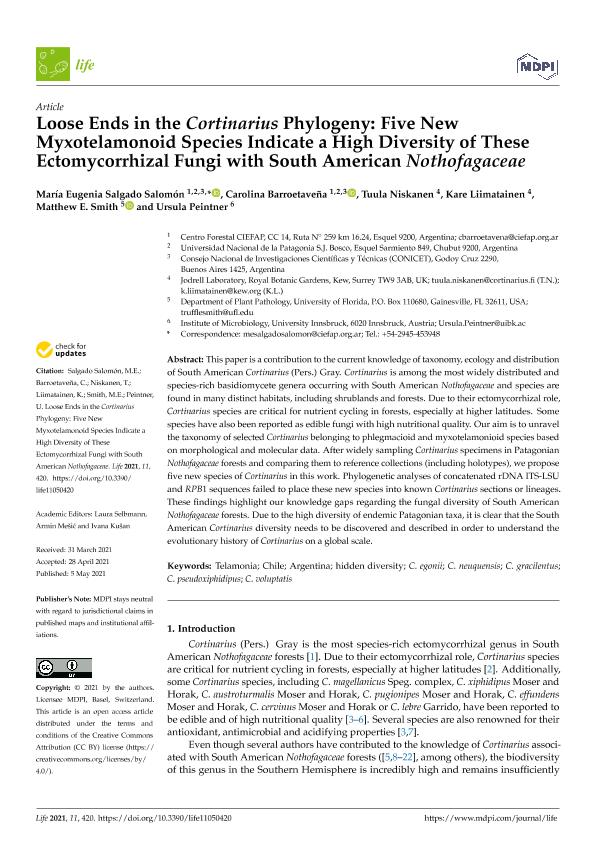Artículo
Loose ends in the Cortinarius phylogeny: five new myxotelamonoid species indicate a high diversity of these ectomycorrhizal fungi with south american Nothofagaceae
Salgado Salomón, María Eugenia ; Barroetaveña, Carolina
; Barroetaveña, Carolina ; Niskanen, Tuula; Liimatainen, Kare; Smith, Matthew E.; Peintner, Ursula
; Niskanen, Tuula; Liimatainen, Kare; Smith, Matthew E.; Peintner, Ursula
 ; Barroetaveña, Carolina
; Barroetaveña, Carolina ; Niskanen, Tuula; Liimatainen, Kare; Smith, Matthew E.; Peintner, Ursula
; Niskanen, Tuula; Liimatainen, Kare; Smith, Matthew E.; Peintner, Ursula
Fecha de publicación:
05/2021
Editorial:
Multidisciplinary Digital Publishing Institute
Revista:
Life
e-ISSN:
2075-1729
Idioma:
Inglés
Tipo de recurso:
Artículo publicado
Clasificación temática:
Resumen
This paper is a contribution to the current knowledge of taxonomy, ecology and distribution of South American Cortinarius (Pers.) Gray. Cortinarius is among the most widely distributed and species-rich basidiomycete genera occurring with South American Nothofagaceae and species are found in many distinct habitats, including shrublands and forests. Due to their ectomycorrhizal role, Cortinarius species are critical for nutrient cycling in forests, especially at higher latitudes. Some species have also been reported as edible fungi with high nutritional quality. Our aim is to unravel the taxonomy of selected Cortinarius belonging to phlegmacioid and myxotelamonioid species based on morphological and molecular data. After widely sampling Cortinarius specimens in Patagonian Nothofagaceae forests and comparing them to reference collections (including holotypes), we propose five new species of Cortinarius in this work. Phylogenetic analyses of concatenated rDNA ITS-LSU and RPB1 sequences failed to place these new species into known Cortinarius sections or lineages. These findings highlight our knowledge gaps regarding the fungal diversity of South American Nothofagaceae forests. Due to the high diversity of endemic Patagonian taxa, it is clear that the South American Cortinarius diversity needs to be discovered and described in order to understand the evolutionary history of Cortinarius on a global scale.
Archivos asociados
Licencia
Identificadores
Colecciones
Articulos(SEDE CENTRAL)
Articulos de SEDE CENTRAL
Articulos de SEDE CENTRAL
Citación
Salgado Salomón, María Eugenia; Barroetaveña, Carolina; Niskanen, Tuula; Liimatainen, Kare; Smith, Matthew E.; et al.; Loose ends in the Cortinarius phylogeny: five new myxotelamonoid species indicate a high diversity of these ectomycorrhizal fungi with south american Nothofagaceae; Multidisciplinary Digital Publishing Institute; Life; 11; 5; 5-2021; 1-22
Compartir
Altmétricas



